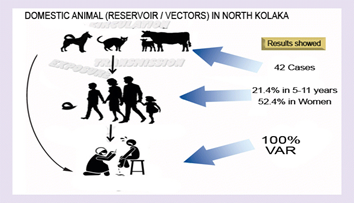Rabies in Animal Bite Victims: How to Handle in North Kolaka Regency
Abstract
Rabies is one of the most important zoonoses in the world with a high impact on public health. Rabies disease in Indonesia is one of the public health problems with a high level of endemicity that has spread in 24 out of 34 provinces in Indonesia. In Indonesia, there are an average of 80,861 cases and 103 deaths per year from rabies transmitting animal bites (GHPR). From January to May 2019, there were 41 GHPR cases and 1 death case or 2.4% CFR in North Kolaka Regency. This research is descriptive with a qualitative approach. The population in this study is 42 cases of GHPR, all of which act as samples. The results showed that most cases of rabies were experienced by women (52.4%), the age of most people with rabies was the occupations of most of the sufferers (23.8%) were students and housewives, the ownership status of the animals was mostly wild animals (66.67%), and the bite history was mostly unprovoked (92.8%). This study recommends that joint efforts are needed to control rabies from the animal and human health sectors with a synergistic approach.

Downloads
References
Akoso, B.T., 2007. Pencegahan dan Pengendalian Rabies: Penyakit Menular Pada Hewan dan Manusia. Kanisius
Aziz, H., Rhee, P., Pandit, V., Tang, A., Gries, L., & Joseph, B. (2015). The current concepts in management of animal (dog, cat, snake, scorpion) and human bite wounds. Journal of Trauma and Acute Care Surgery, 78(3), 641-648. https://doi.org/10.1097/TA.0000000000000531
Baxter, J. M. (2012). One in a million, or one in thousand: What is the morbidity of rabies in India?. Journal of global health, 2(1). https://dx.doi.org/10.7189%2Fjogh.02.010303
Briggs, D. J. (2012). The role of vaccination in rabies prevention. Current opinion in virology, 2(3), 309-314. https://doi.org/10.1016/j.coviro.2012.03.007
Castillo-Neyra, R., Toledo, A. M., Arevalo-Nieto, C., MacDonald, H., De la Puente-León, M., Naquira-Velarde, C., & Levy, M. Z. (2019). Socio-spatial heterogeneity in participation in mass dog rabies vaccination campaigns, Arequipa, Peru. PLoS neglected tropical diseases, 13(8), e0007600. https://doi.org/10.1371/journal.pntd.0007600
Dinas Kesehatan Kabupaten Kolaka Utara. (2019). Laporan Program Rabies.
El-Neweshy, M. S., Al Mayahi, N., Al Mamari, W., Al Rashdi, Z., & Al Mawly, J. H. (2020). Animal rabies situation in Sultanate of Oman (2017–2019). Tropical Animal Health and Production, 52(6), 3069-3076. https://doi.org/10.1007/s11250-020-02328-0
Fooks, A. R., Banyard, A. C., Horton, D. L., Johnson, N., McElhinney, L. M., & Jackson, A. C. (2014). Current status of rabies and prospects for elimination. The Lancet, 384(9951), 1389-1399. https://doi.org/10.1016/S0140-6736(13)62707-5
Gongal, G., & Wright, A. E. (2011). Human rabies in the WHO Southeast Asia Region: forward steps for elimination. Advances in preventive medicine, 2011. https://doi.org/10.4061/2011/383870
Hampson, K., Coudeville, L., Lembo, T., Sambo, M., Kieffer, A., Attlan, M., & Global Alliance for Rabies Control Partners for Rabies Prevention. (2015). Estimating the global burden of endemic canine rabies. PLoS neglected tropical diseases, 9(4), e0003709. https://doi.org/10.1371/journal.pntd.0003709
Jamari, E. J., & Nurdin, F. (2019). Faktor pelayanan kesehatan, dukungan keluarga dan masyarakat dengan upaya pencegahan kejadian rabies di wilayah kerja Puskesmas Pandan Kecamatan Sungai Tebelian Kabupaten Sintang. VISIKES: Jurnal Kesehatan Masyarakat, 18(2). https://doi.org/10.33633/visikes.v18i2.2300
Jimenez, I., Spraker, T., Anderson, J., Bowen, R., & Gilbert, A. (2019). Isolation of rabies virus from the salivary glands of wild and domestic carnivores during a skunk rabies epizootic. Journal of wildlife diseases, 55(2), 473-476. https://doi.org/10.7589/2018-05-127
Kemenkes R.I. (2016). Buku saku petunjuk teknis penatalaksanaan kasus gigitan hewan penular rabies di Indonesia..
Lee, H. S., Thiem, V. D., Anh, D. D., Duong, T. N., Lee, M., Grace, D., & Nguyen-Viet, H. (2018). Geographical and temporal patterns of rabies post exposure prophylaxis (PEP) incidence in humans in the Mekong River Delta and Southeast Central Coast regions in Vietnam from 2005 to 2015. PLoS One, 13(4), e0194943. https://doi.org/10.1371/journal.pone.0194943
Leung, A. K., Davies, H. D., & Hon, K. L. E. (2007). Rabies: epidemiology, pathogenesis, and prophylaxis. Advances in therapy, 24(6), 1340-1347. https://doi.org/10.1007/BF02877781
Ma, X., Blanton, J. D., Millien, M. F., Medley, A. M., Etheart, M. D., Fénelon, N., & Wallace, R. M. (2020). Quantifying the risk of rabies in biting dogs in Haiti. Scientific reports, 10(1), 1-10. https://doi.org/10.1038/s41598-020-57908-9
Padmawati, H. R. S. Persepsi Masyarakat Terhadap Penyakit Rabies. Berita Kedokteran Masyarakat, 27(3), 117. https://doi.org/10.22146/bkm.3398
Pantha, S., Subedi, D., Poudel, U., Subedi, S., Kaphle, K., & Dhakal, S. (2020). Review of rabies in Nepal. One Health, 100155. https://doi.org/10.1016/j.onehlt.2020.100155
Rana, M. S., Jahan, A. A., Kaiser, S. G., Siddiqi, U. R., Sarker, S., Begum, M. I. A., & Shamsuzzaman, A. K. M. (2021). Knowledge, attitudes and perceptions about rabies among the people in the community, healthcare professionals and veterinary practitioners in Bangladesh. One Health, 100308. https://doi.org/10.1016/j.onehlt.2021.100308
Simani, S., Fayaz, A., Rahimi, P., Eslami, N., Howeizi, N., & Biglari, P. (2012). Six fatal cases of classical rabies virus without biting incidents, Iran 1990–2010. Journal of clinical virology, 54(3), 251-254. https://doi.org/10.1016/j.jcv.2012.03.009
Vigilato, M. A. N., Clavijo, A., Knobl, T., Silva, H. M. T., Cosivi, O., Schneider, M. C., & Espinal, M. A. (2013). Progress towards eliminating canine rabies: policies and perspectives from Latin America and the Caribbean. Philosophical Transactions of the Royal Society B: Biological Sciences, 368(1623), 20120143. https://doi.org/10.1098/rstb.2012.0143
Copyright (c) 2021 Author(s)

This work is licensed under a Creative Commons Attribution-NonCommercial-ShareAlike 4.0 International License.
Authors retain copyright and grant the journal right of first publication with the work simultaneously licensed under a Creative Commons Attribution-NonCommercial-ShareAlike 4.0 International License that allows others to share the work with an acknowledgment of the work's authorship and initial publication in this journal.
Authors are able to enter into separate, additional contractual arrangements for the non-exclusive distribution of the journal's published version of the work (e.g., post it to an institutional repository or publish it in a book), with an acknowledgment of its initial publication in this journal.
Authors are permitted to publish their work online in third parties as it can lead to wider dissemination of the work.




